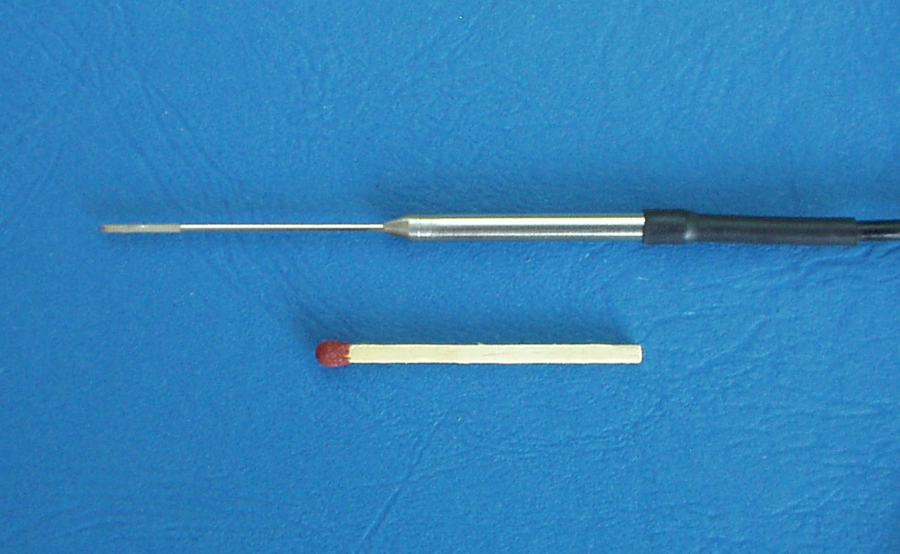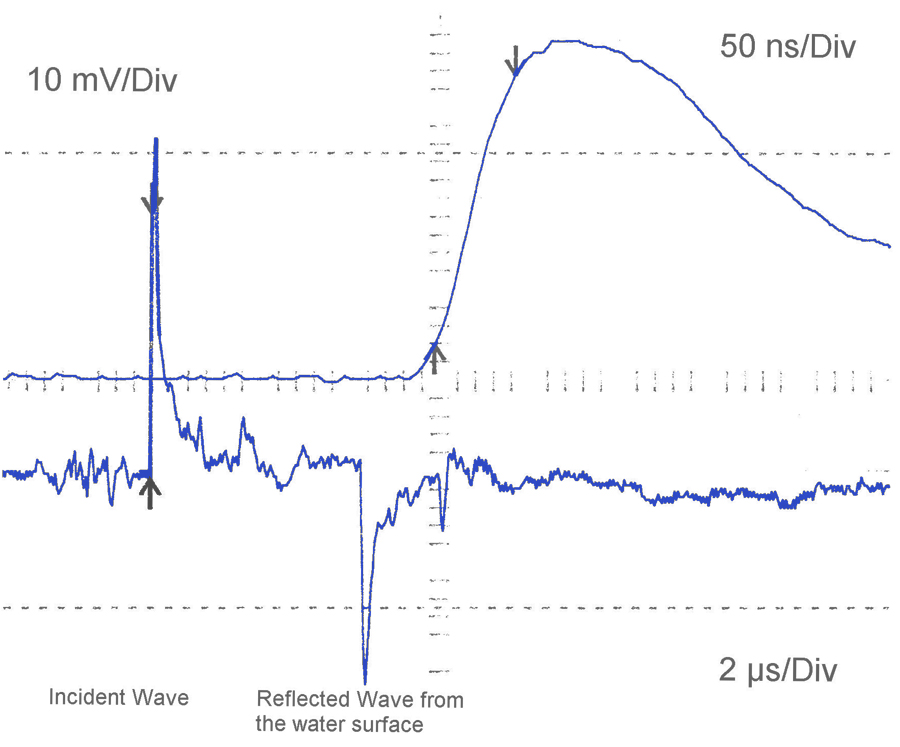Müller-Platte Needle Probe
Typical Applications
The Müller-Platte Needle Probe was invented at the University of Aachen 1985 for measurements of low energy water shock waves for developing the kidney stone lithotripter and for focusing ultrasound waves.
This special micro gauge based on pvdf is designed for high-energy ultrasound measurements as well as for recording blast waves in water up to some kbar. With its half spherical head, small sensitive diameter (< 0.5 mm) and the very short rise time of about 50 ns the hydrophone is the ideal device for distribution measurements in focal regions of ultrasonic transducers or e.g. kidney stone lithotriptors. Other applications are measurements of laser generated shock waves, cavitation effects or applications in medical and military research.
Still today this probe is the Gold Standard for pressure measurements of water shock waves. Within these years the Müller-Platte Needle Probe has demonstrated its reliability and durability in multiple experiments worldwide, especially under very short shock wave pressures.
For recording the signal we recommend a direct connection to the 1 MOhm inputs of the recorder. For very small pressures, quite long signal duration and longer cables than 3 m we offer our special high bandwidth charge amplifier, MCPA 10, which runs cable lengths up to 150 m.
Technical Data
|
Pressure range: |
-100 to 1500 bar (-10 to 150 MPa) |
|
Sensitive element: |
Piezoelectric PVDF |
|
Rise time: (10% to 90%): |
50 ns |
|
Sensitive diameter: |
< 0,5 mm |
|
Sensitivity: |
About 0.3 pC/bar or 1 mV/bar incl. 2 m cable |
|
Bandwidth: |
0.3 – 11 MHz ± 3.0 dB |
|
Temperature range: |
Max. 60°C |
|
Calibration: |
Shock wave calibrated up to 20 bars in water. (const. sensitivity could be verified up to 320 bar); calibrated on the incident shock wave |
|
Tube diameter: |
1.2 mm at the tip, 4.0 mm for mounting, stainless steel |
|
Cable: |
2 m coaxial cable; for longer connections please use charge amplifier MCPA 10 |
|
Connexion: |
BNC pos. |
|
Recording: |
To a 1 MOhm Input |
|
Article-No.: |
00-100-1 Müller-Platte Needle Probe with 2 m cable and BNC plug |
For special applications the hydrophone can be delivered in almost any wished size and shape, different cable lengths (shorter) or connectors. Please give detailed information (incl. drawing) about your desired application and ask for a quotation.
Publications
M. Müller, M. Platte
Einsatz einer breitbandigen Drucksonde auf PVDF-Basis zur Untersuchung konvergierender Stoßwellen in Wasser, Acustica Vol. 58, 1985, S. 215-222
M. Müller
Experimental investigations on Focusing of Weak Spherical Shock Waves in Water by Shallow Ellipsoidal Reflectors, Acustica Vol. 64, 1987, S. 85-93
M. Müller
Use of Various Ellipsoidal Reflectors for Focusing Water Shock Waves for Lithotripsy, Biomed. Technik, 34, Heft 4, 1989 komp
Michael Müller
Focusing of Shock Waves in Water - Thesis Summary
Sommerfeld, M. und Müller, M.
Experimental and Numerical Studies of Shock Wave Focusing in Water, Experiments in Fluids, 6, 209-216 (1988)
M. Müller
Experimentelle Untersuchungen zur Fokussierung sphärischer Stoßwellen in Wasser durch ellipsoide Reflektoren, Acustica, 66, 258-266, (1988)
M. Müller
Stoßwellenfokussierung in Wasser, Dissertation, RWTH Aachen (1987)
M. Müller
Focusing of Shock Waves in Water by Different Ellipsodial Reflectors, Proc. 17th Int. Symp. on Shock Waves and Tubs, Bethlehem, Pennsyl. (1989)
M. Müller
Dornier Lithotripter im Vergleich, Biomed. Technik, 1991
K. Rink, G. Delacrétaz, R. P. Salathé
Fragmentation process induced by nanosecond laser pulses, Appl. Physics Letters, Vol. 61 (22), 1992
Müller, H.M. and H. Grönig
Experimental Investigations and Shock Wave Focusing in Water, Proc. 12th Int. Cong: on Acoustics, H3-3, Toronto, Canada (1986)
Deutz, F.-J., Fischer, N., Rübben, H., Lutzeyer, W., Müller, M. und Teichmann, R.
Die Beeinflussung des Stoßwellenfeldes bei der ESWL durch intrarenale Störkörper, Proc. 8th Symposium für experimentelle Urologie, Mainz (1986)
Fischer, N., Rübben, H., Müller, M. und Lutzeyer, W.
Die Wirkung hochenergetischer Stoßwellen auf das BBN-induzierte Harnblasenkarzinom der Ratte, Verh.-Berichte der Deut. Gesell. für Urologie, 38. Tagung (1986)
Forßmann, B., Grünewald, M., Müller, M.
Technologien für die Erzeugung von Stoßwellen zur Steinzertrümmerung, Mathematik-Naturwissenschaft Ingenieurwesen (1988)
Delius, M., Müller, M., Vogel, A. and Brendel, W.
Shock Waves and Cavitation, Biliary Lithotripsy, Editors: J. T. Ferrucci, M. Delius, H. J. Burhenne, Year Book Medical Publishers, Chicago/ London/ Boca Raton (1988)
Delius, M., Müller, M., Vogel, A. and Brendel, W.
Extracorporal Shock Waves: Properties and Principles of Generation, Biliary Lithotripsy, Editors: J.T. Ferrucci; Delius, M., Burhenne, H.J., Year Book Medical Publishers, Chicago/London/ Boca Raton (1988)
Fischer, N., Müller, M., Gülhan, A., Sohn, M., Deutz, F.-J., Rübben, H. and Lutzeyer, W.
Cavitation Effects: Possible Cause of Tissue Injury During Extracorporal Shock Wave Lithotripsy, Journal of Endourologie, 2, No. 2 (1988)


